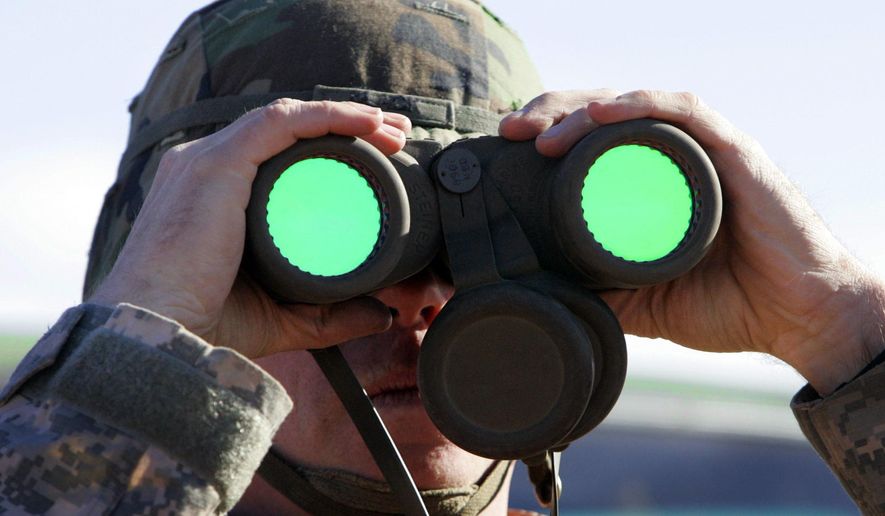HOUSTON (AP) - Since he launched his run for president, Donald Trump has said things about immigrants and the U.S.-Mexico border that no other U.S. president has. But now he’s reached directly into his predecessors’ playbook by sending in the National Guard.
When former presidents George W. Bush and Barack Obama deployed the Guard to the border in 2006 and 2010, they were pushing Congress to pass wide-ranging overhauls of immigration policy. Both overhauls failed. A 2011 government review estimated the Bush and Obama deployments cost at least $1.3 billion.
Trump is also trying to reshape immigration law. But Congress so far has funded a fraction of the border wall he promised during his campaign, so the president said this week he wants 2,000 to 4,000 Guard troops on the frontier until the wall goes up. Trump called the deployments crucial to helping the U.S. Border Patrol, which after a drop-off last year has returned to apprehending about as many people as it typically does.
In a tweet Saturday, Trump said: “We are sealing up our Southern Border. The people of our great country want Safety and Security.’
Texas and Arizona officials said the first 400 soldiers will be in place within days, and Defense Secretary James Mattis said the Pentagon would foot the bill for the full 4,000, if needed, through September.
Here’s a closer look at the recent history of National Guard deployments, what the presidents who ordered them said at the time and what the state of the border was then versus now:
___
OPERATION JUMP START, June 2006-July 2008
WHAT THE PRESIDENT SAID: “For decades, the United States has not been in complete control of its borders,” Bush said. “As a result, many who want to work in our economy have been able to sneak across our border, and millions have stayed.”
In announcing the operation, Bush called on Congress to pass “comprehensive immigration reform.” Using rhetoric very different than Trump’s, Bush called immigrants without legal status “a part of American life.”
“These are real problems. Yet we must remember that the vast majority of illegal immigrants are decent people who work hard, support their families, practice their faith, and lead responsible lives,” he said.
HOW MANY TROOPS: Up to 6,000 Guard members in the first year, reduced to 3,000 in the second year.
WHERE: About 2,400 were sent to Arizona in the first year, according to a 2008 review the Guard published about the operation. Another 1,500 were sent to Texas that year, 1,200 to California, and 900 to New Mexico. The Guard members came from all over the United States.
WHY: Bush said he was trying to buy time to bolster Border Patrol staffing, which eventually grew by about one-third. He said the troops would assist Border Patrol by “operating surveillance systems, analyzing intelligence, installing fences and vehicle barriers, building patrol roads, and providing training.” He said Guard members would not assume law enforcement responsibilities and that the U.S. “is not going to militarize the southern border.”
WHAT THE GUARD DID: While Guard members could not make arrests on their own, according to government figures for the two-year operation, Guard members helped in almost 12 percent of migrant apprehensions and 9 percent of border marijuana seizures.
COST: $1.2 billion, according to the U.S. Government Accountability Office.
PROBLEMS: In a 2009 article for Joint Force Quarterly, Maj. David M. Church, an Army National Guard commander during Operation Jump Start, said the operation’s “sudden formation” gave the National Guard and U.S. Customs and Border Protection “little time for preparation, acquaintance, and coordination.” The two agencies struggled to communicate and share information “without prior coordination and a solid unity of effort between them,” though those issues eased over time.
___
OPERATION PHALANX, July 2010-Sept. 2011
WHAT THE PRESIDENT SAID: “We’re not going to solve the problem just solely as a consequence of sending National Guard troops down there,” Obama said. “We’re going to solve this problem because we have created an orderly, fair, humane immigration framework in which people are able to immigrate to this country in a legal fashion; employers are held accountable for hiring legally present workers.”
HOW MANY: Up to 1,200 Guard members initially, though some remained in operations that continued beyond the initial deployment.
WHERE: About 560 members were sent to Arizona. According to Maj. Gen. Hugo Salazar, the head of the National Guard in Arizona, all four Southwest border states supported the operation with their own Guard members.
WHY: Obama said the Guard could “help on intelligence, dealing with both drug and human trafficking along the borders” and free up Border Patrol to handle more law enforcement duties.
WHAT THE GUARD DID: According to a Government Accountability Office review of figures from the start of the deployment through May 2011, the Guard assisted in 6 percent of all migrant apprehensions and 2.6 percent of marijuana seizures.
COST: $110 million through the first year, according to the Government Accountability Office.
PROBLEMS: Critics questioned whether the deployment was worth the expense, especially since Guard members could not make arrests on their own. John David Franz, the mayor of the border city of Hidalgo, Texas, told The Washington Post: “As a mayor, I am not going to say we don’t want more security. But as a taxpayer? I would say something different.”




Please read our comment policy before commenting.